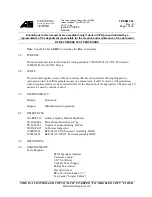
Using I/Os in S7–400H
13.4 Connecting redundant I/O to the PROFIBUS DP interface
S7-400H
198
System Manual, 03/2012, A5E00267695-11
Information on connecting with diodes
●
Suitable diodes are diodes with U
_r
>=200 V and I_
F
>= 1 A (e.g. types from the series
1N4003 ... 1N4007).
●
It is advisable to separate the ground of the module and the ground of the load. There
must be equipotential bonding between both.
Using analog input modules as redundant I/O
You specified the following parameters when you configured the analog input modules for
redundant mode:
●
Tolerance window (configured as a percentage of the end value of the measuring range)
Two analog values are considered equal if they are within the tolerance window.
●
Discrepancy time (maximum permitted time in which the redundant input signals can be
outside the tolerance window). The configured discrepancy time must be a multiple of the
update time of the process image and therefore also the basic conversion time of the
channels.
An error is generated when there is an input value discrepancy after the configured
discrepancy time has expired.
If you connect identical sensors to both analog input modules, the default value for the
discrepancy time is usually sufficient. If you use different sensors, in particular
temperature sensors, you will have to increase the discrepancy time.
●
Applied value
The applied value represents the value of the two analog input values that is accepted in
the user program.
The system verifies that the two read-in analog values are within the configured tolerance
window. If they are, the applied value is written to the lower data memory area of the process
input image. If there is a discrepancy and it is the first, it is marked accordingly and the
discrepancy time is started.
When the discrepancy time is running, the most recent valid value is written to the process
image of the module with the lower address and made available to the current process. If the
discrepancy time expires, the module/channel with the configured standard value is declared
as valid and the other module/channel is passivated. If the maximum value from both
modules is parameterized as the standard value, this value is then taken for further program
execution and the other module/channel is passivated. If the minimum value is configured,
this module/channel supplies the data to the process and the module with the maximum
value is passivated. In any case, the passivated modules/channels are entered in the
diagnostic buffer.
Содержание SIMATIC S7-400H
Страница 24: ...Preface 1 1 Preface S7 400H 24 System Manual 03 2012 A5E00267695 11 ...
Страница 46: ...Getting Started 4 5 Special layout features of SIMATIC Manager S7 400H 46 System Manual 03 2012 A5E00267695 11 ...
Страница 120: ...Memory concept 10 1 Overview of the memory concept of S7 400H CPUs S7 400H 120 System Manual 03 2012 A5E00267695 11 ...
Страница 258: ...Communication 14 8 General issues regarding communication S7 400H 258 System Manual 03 2012 A5E00267695 11 ...
Страница 354: ...Synchronization modules 18 3 Selecting fiber optic cables S7 400H 354 System Manual 03 2012 A5E00267695 11 ...
Страница 434: ...Technical data 20 6 Runtimes of the FCs and FBs for redundant I Os S7 400H 434 System Manual 03 2012 A5E00267695 11 ...
Страница 460: ...Function modules and communication processors supported by the S7 400H S7 400H 460 System Manual 03 2012 A5E00267695 11 ...
















































